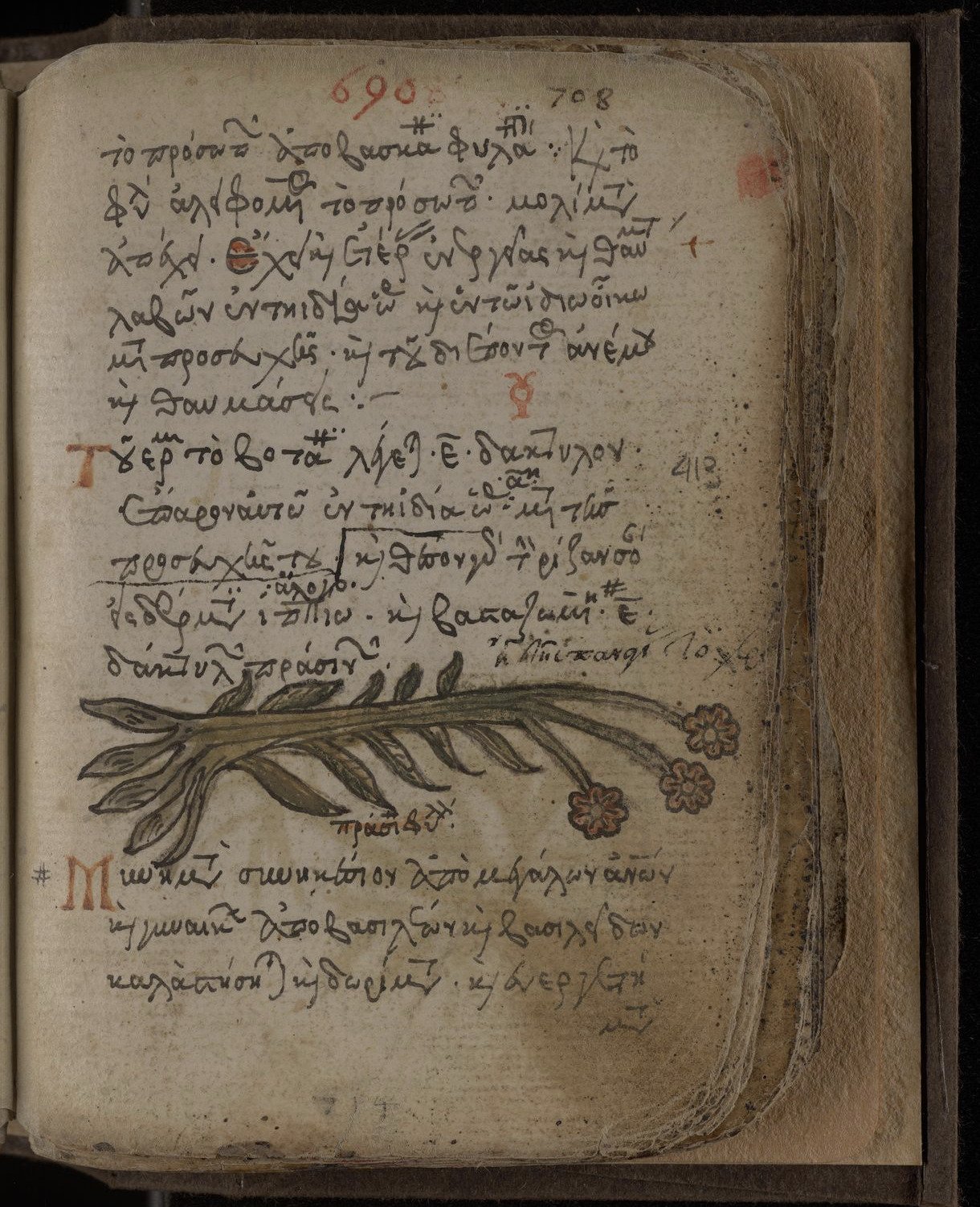Iatrosophion
Regarded as a genre of Greek literature on medical wisdom, possibly originating in Byzantium, Iatrosophion was a Graeco-Egyptian manuscript that was used by Greek healers and practitioners of medicine and possibly put together sometime during the 16th & 18th century; potentially in Crete. Text contains 70 sections and is written in at least 5 different hands. Within the book itself, it contains pages that are foliated in parts - layering of foliage onto pages with a majority of its pages numbered (almost similar to the Voynich manuscript). However, several editions contain many pages that are missing and are unnumbered.
Derived from Ancient Greek, Iatrosophia means ‘doctor’ and ‘knowledge’, which subsequently gave rise to the word, ‘Iatrosophist’ denoting a learned person or professor/doctor of medicine. The Itrosophion contains “Greek medical treatise, information on botanical remedies, pharmacology, popular cures, astrological medicine (with charts), list of good and bad days for phlebotomy, magical script, Cabalistic symbols, Zodiac signs, pseudo-Solomonic pentacles, invocations of angels and demons, amuletic texts, spells and prognostications.” It also includes “Vasileia Solomomtos”, the Greek version of the Clavicula Salomonis.
Books such as Iatrosophia serve as a window into what the Greeks knew about anatomy and their medical knowledge under the Ottoman empire (mid-1400’s to the early 1800’s), as they focused on empirical diagnostics and therapeutics - none of which were theoretical. An Iatrosophion was a physician’s notebook of recipes and treatments and/or a collective of classical Byzantine medical and pharmacological texts consulted in hospital settings - a compendia of recipes and therapeutic advice. Some Iatrosophia (plural) included medical cures and drugs, but spells, exorcisms, magic, astrology, and practical advice was included as well. In conjunction with interpreting a dream symbol, this grimoire was used to advise on a prophylactic cure (usually dietary) or treatment for restoring and maintaining health along with religious prayer, spells or apotropaic magic. Important to note that medical dreams were not discussed by Greek dream interpreters, but were the domain of physicians like Hippocrates, Galen, and Rufus of Ephesus or any follower of the healing god, Asclepius. Widely used in Byzantine and Ottoman Greece, it is worth mentioning that it was also commonplace for monks and nuns in monastic hospitals to prepare, use and dispense remedies based on Iatrosophia texts.
While some of these texts date back as early as 10th century CE, it is the 15th century and onward texts that are more commonly found making up the larger percentage of Iatrosophia to have survived to present day. The Iatrosphist tradition, especially after the Byzantium fall, was maintained by the Greek Orthodox monasteries and in Greek secular parts of the Ottoman Empire, also surviving into the 20th century. These texts were heavily influenced by earlier Greek and Latin medical writing by Hippocratic authors, Dioscorides and Galen for example, and later Byzantine writers of the 4th to 7th centuries CE, as well. Arabic medical influence from the 10th century is also evident in the Iatrosophia, indicating that these were living texts and continuously updated by the authors of this genre when new experiences and information became available. It seems that the interest in anatomy in Greece intensified in texts after the Neohellenic Enlightenment (1705-1821) and while anatomy had been discussed by various authors in various contexts, it wasn't until the 18th century that Greek scholars show consensus on the importance of anatomy and hence to translations of anatomical knowledge into the language and literature. It is somewhat believed by the 19th and 20th century medical historians that these texts were “corrupt and degraded forms of prestigious classical medicine”, yet recent research has supported Iatrosophia to be ‘intellectually valid work’ and ‘reflect clinically effective pharmacology’. Because of this genre of grimoire, we see that medicine was practiced by both university-trained physicians & pharmacists and empirical healers of this era and their knowledge compiled into manuscripts from both camps. Also, very few texts of this genre have been edited or translated, still existing in these manuscript forms. A survey of 700 Ottoman-era Greek medical manuscripts showed that close to 50% were Iatrosophia, which is where the word iatrosophia was first encountered as the name of the books the Byzantine physicians used.
The medical manuscripts of Iatrosophia were divided into 2 sections: (1) between those who had a known author and those whose authors were unknown, then (2) further divided between identification and background of erudite or university-educated vs folk authors. Because it was a source of medical knowledge for a wide range of practitioners, many of whom did not have formal education, they contain an elaborate body of information on several aspects of diagnostics and therapeutics such as botany and folk medicine.
However, despite the enormity of their practical knowledge, these historical texts describing medicinal plants and minerals all fall victim to the same common problem - their identification. Standardized plant nomenclature or universal latin names of plants would not occur until until the mid-1700’s with Carl Linneaus, Systema Naturae (1735) and therefore the extent of the information on the plant of interest would appear only as the common name the plant as referred to in the local vernacular of that time period; which is most often not in use today. And to add an additional layer of complication - depending on region, culture and time period - the same plant name could also refer to different plant names as well.
There have been numerous studies recently looking into the Iatrosophia texts and have found significant and relevant bioscientific data confirming its rational use; concluding them as an invaluable resource for ethnopharmacological and natural product remedies.









